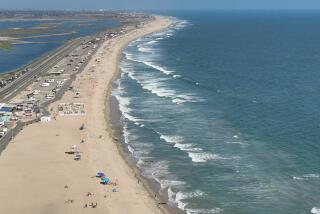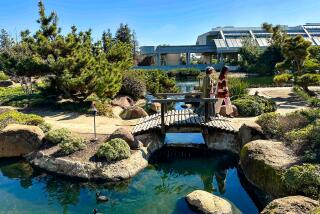Sculpting in Sand Builds Bridges : Imperial Beach and other communities involve children in summertime projects that can appeal to parents, too.
- Share via
The next time you head for the beach, along with the sunscreen, pails and shovels, don’t forget the ice cream scoop, spatula, ruler, butter knife, spray bottle and gardening trowel.
I’m not kidding. You can use them to transform your family into a team of artists capable of producing wonderful sculptures: whimsical mermaids and intricate castles, ferocious dragons and tall towers, all built out of sand and as large as the kids want to build them. And even if you don’t build one yourself, remember that the United States is filled with sand sculpture contests that your children will love.
“It’s a lot of fun and much easier than it looks,” promises veteran sand sculptor Thea Haubrich, a first grade teacher at St. Gregory the Great school in Virginia Beach, Va., who last year led a team of 115 youngsters to victory in the city’s Neptune Festival Sandcastle Classic. Their winning sculpture was an astonishing 25-foot dragon reading a book. Her sand-castle secret: Pack the sand hard (having kids jump up and down on it is effective) and keep it as wet as possible with pails and spray bottle.
“Sand sculpting appeals to the child in all of us,” observed prize-winning sculptor Kali Bradford, one of the founders of the Solana Beach-based World Association of Sand Sculptors.
Bradford, who lives in Bellingham, Wash., taught San Diego area school children the art of sand sculpting for nine years under the auspices of a National Endowment for the Arts grant. “I’ve always built sand sculptures with my own kids,” Bradford said. “It makes for a great family hobby.”
She is currently working on sculptures for Big Rock Gardens of Art, a free, public sand sculpture and horticultural garden in Bellingham, set on 2 1/2 acres overlooking Bellingham Harbor. There Bradford is building a 40-ton sand sculpture--the first of three she expects to complete at the park this summer. Also at the park, which will remain open through October, she is holding summer workshops for children and families in Bellingham. (Call 206-671-1069 for more information on the classes, as well as the fees.)
There are more than 85 sand sculpting contests in the United States, Bradford said, with many families competing as teams. Some contests even offer special children’s events. That includes the nation’s largest--the U.S. Open Sand Castle Contest on the pier at Imperial Beach, just south of San Diego. Started in 1981 on a $350 budget, it is still totally staffed by volunteers and attracts as many as 200,000 people a day to watch hundreds of sand sculptors at work--including the youngsters participating in the special Kids N’ Kastle children-only event. This year’s contest is July 16-18. (Call 619-424-6663.)
On the East Coast, the nation’s oldest sand sculpting contest, called Sand Blast, is still going strong. Begun in 1954 as a Fort Lauderdale, Fla., recreation department project, the contest now stretches down 600 yards of beach with hundreds of castles. It will be held on July 4 (305-761- 5388).
Thea Haubrich’s school team will defend its title in the Neptune Festival Sept. 24 in Virginia Beach (804-498-0215). And on Texas’ Padre Island, the C-Sculptures contest raises money for the Texas Special Olympics June 12 (512-289-1000).
Of course the longer you’re out on the beach building castles, the more important it becomes to protect the kids--and yourself--from too much sun.
Studies have proven a correlation between childhood sun exposure and later development of skin cancer, said Dr. Amy Pallar, a dermatologist and professor at Northwestern University Medical school in Chicago. Because sun screens haven’t been tested sufficiently on babies, the best advice is not to use one but to keep infants in the shade, Dr. Pallar advised.
For children over six months, use a sunscreen with a sun protection factor (SPF) of at least 15. For her family, Dr. Pallar uses those that are water resistant and provide 6-hour protection. And some new products offer protection from ultra violet B rays, as well as A rays--a fact that is indicated on the labels as “UVA” and “UVB” protection.
But no matter how well you’ve applied sunscreen, get the kids out of the sun every 90 minutes or so for a 10-15 minute break, Dr. Pallar said. Give them plenty to drink, so they don’t get dehydrated. And make sure they’re wearing protective clothing. T-shirts offer little protection. “Look for cotton that has as tight a weave as possible,” Pallar said. Her kids are partial to the new foreign legion-style hats that have a back flap.
You may also want to consider clothing made of the new light- weight fabrics designed specifically to offer protection from the sun. Two companies offer such hats and clothing for children: Seattle-based Solumbra (800-882-7860) and Arizona-based Frogskin (800- 354-0203). Sunglasses with UV protection also are a good bet.
Once they’re smeared with cream and dressed like legionnaires, you can relax and build the world’s best sand castle/sea creature you’ve ever seen.
Taking the Kids invites reader questions and comments about family travel. Address them to: Taking the Kids, 2859 Central St., Box 119, Evanston, Ill. 60201.






